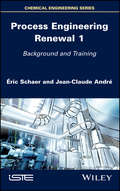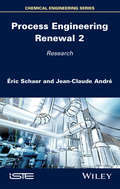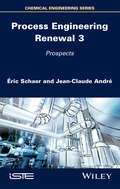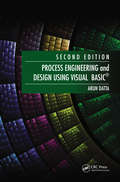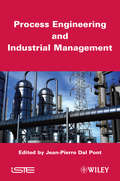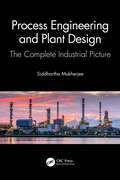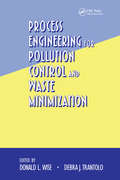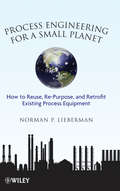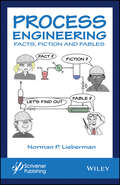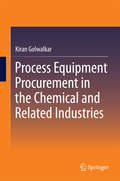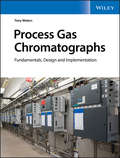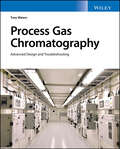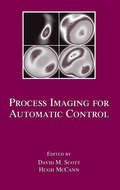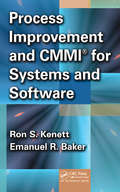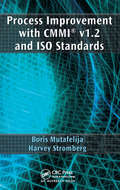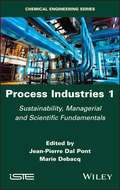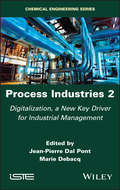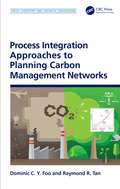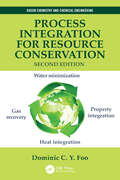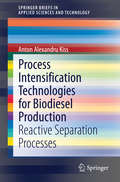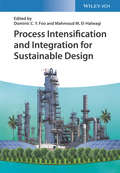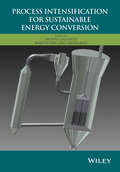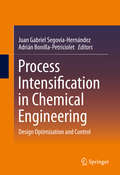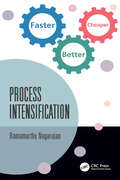- Table View
- List View
Process Design for Cryogenics
by Alexander AlekseevUp-to-date overview of the method for producing the main industrial gases This book covers process design for cryogenic processes like air separation, natural gas liquefaction, and hydrogen and helium liquefaction. It offers an overview of the basics of cryogenics and information on process design for modern industrial plants. Throughout, the book helps readers visualize the theories of thermodynamics related to cryogenics in practice. A central concept in the book is the connection between the theoretical world of process design and the real limitations given by available hardware components and systems. Sample topics covered in Process Design for Cryogenics include: Cryogenic gases like nitrogen, oxygen, argon, neon, hydrogen, helium, and methaneThermodynamicsTypical cryogenic refrigeration processes, including the classic Joule Thomson process, the contemporary mixed-gas Joule Thomson process, and expander-based processes like Brayton and Claude cyclesHelium and hydrogen liquefaction and air separation Process Design for Cryogenics is a comprehensive must-have resource for engineers and scientists working in academia and industry on cryogenic processes.
Process Engineering Renewal 1: Background and Training
by Jean-Claude André Éric SchaerProcess engineering emerged at the beginning of the 20th Century and has become an essential scientific discipline for the matter and energy processing industries. Its success is incontrovertible, with the exponential increase in techniques and innovations. Rapid advances in new technologies such as artificial intelligence, as well as current societal needs – sustainable development, climate change, renewable energy, the environment – are developments that must be taken into account in industrial renewal. Process Engineering Renewal 1 – the first volume of three – focuses on training, demonstrating the need for innovation in order for the field to have a framework that is sustainable, in a highly changeable world.
Process Engineering Renewal 2: Research
by Eric Schaer Jean-Claude AndreThe chemical processes initially consisted of non-scientific extrapolation methods from the "laboratory". Coming from the oil industry, chemical engineering, now process engineering (material and energy transformation) has introduced scientific rationality in the development of more optimal processes both in financial terms and saving material and energy. At the end of the twentieth century, heavy trends force us to modify our ways of doing matter and/or energies: depletion of reserves, pollution, globalization, artificial intelligence, public perception of risks, etc. Commodities continue to be produced locally while higher value-added products can come from many countries around the world. These external pressures on training and research in the field require major breaks that are the subject of the book.
Process Engineering Renewal 3: Prospects
by Eric Schaer Jean-Claude AndreThe chemical processes initially consisted of non-scientific extrapolation methods from the "laboratory". Coming from the oil industry, chemical engineering, now process engineering (material and energy transformation) has introduced scientific rationality in the development of more optimal processes both in financial terms and saving material and energy. At the end of the twentieth century, heavy trends force us to modify our ways of doing matter and/or energies: depletion of reserves, pollution, globalization, artificial intelligence, public perception of risks, etc. Commodities continue to be produced locally while higher value-added products can come from many countries around the world. These external pressures on training and research in the field require major breaks that are the subject of the book.
Process Engineering and Design Using Visual Basic
by Arun DattaSoftware tools are a great aid to process engineers, but too much dependence on such tools can often lead to inappropriate and suboptimal designs. Reliance on software is also a hindrance without a firm understanding of the principles underlying its operation, since users are still responsible for devising the design.In Process Engineering and Desi
Process Engineering and Industrial Management
by Jean-Pierre Dal PontProcess Engineering, the science and art of transforming raw materials and energy into a vast array of commercial materials, was conceived at the end of the 19th Century. Its history in the role of the Process Industries has been quite honorable, and techniques and products have contributed to improve health, welfare and quality of life. Today, industrial enterprises, which are still a major source of wealth, have to deal with new challenges in a global world. They need to reconsider their strategy taking into account environmental constraints, social requirements, profit, competition, and resource depletion."Systems thinking" is a prerequisite from process development at the lab level to good project management. New manufacturing concepts have to be considered, taking into account LCA, supply chain management, recycling, plant flexibility, continuous development, process intensification and innovation.This book combines experience from academia and industry in the field of industrialization, i.e. in all processes involved in the conversion of research into successful operations. Enterprises are facing major challenges in a world of fierce competition and globalization. Process engineering techniques provide Process Industries with the necessary tools to cope with these issues. The chapters of this book give a new approach to the management of technology, projects and manufacturing.ContentsPart 1: The Company as of Today1. The Industrial Company: its Purpose, History, Context, and its Tomorrow?, Jean-Pierre Dal Pont.2. The Two Modes of Operation of the Company - Operational and Entrepreneurial, Jean-Pierre Dal Pont.3. The Strategic Management of the Company: Industrial Aspects, Jean-Pierre Dal Pont.Part 2: Process Development and Industrialization4. Chemical Engineering and Process Engineering, Jean-Pierre Dal Pont.5. Foundations of Process Industrialization, Jean-François Joly.6. The Industrialization Process: Preliminary Projects, Jean-Pierre Dal Pont and Michel Royer.7. Lifecycle Analysis and Eco-Design: Innovation Tools for Sustainable Industrial Chemistry, Sylvain Caillol.8. Methods for Design and Evaluation of Sustainable Processes and Industrial Systems, Catherine Azzaro-Pantel.9. Project Management Techniques: Engineering, Jean-Pierre Dal Pont.Part 3: The Necessary Adaptation of the Company for the Future10. Japanese Methods, Jean-Pierre Dal Pont.11. Innovation in Chemical Engineering Industries, Oliver Potier and Mauricio Camargo.12. The Place of Intensified Processes in the Plant of the Future, Laurent Falk.13. Change Management, Jean-Pierre Dal Pont.14. The Plant of the Future, Jean-Pierre Dal Pont.
Process Engineering and Plant Design: The Complete Industrial Picture
by Siddhartha MukherjeeThe book provides the whole horizon of process engineering and plant design from concept phase through the execution to commissioning of the plant in the real practice. Providing a complete industrial perspective, the book: Covers the guidelines and standards followed in the industry and how engineering documents are generated using these standards Describes Hazardous Area Classification, Relief System Design, Revamp Engineering, Interaction with Other Disciplines, and Pre-commissioning and Commissioning Contains several illustrated practical examples, which clarify the fundamentals to a raw chemical engineer Includes description of a complete chemical project from concept to commissioning Treating the topic from the perspective of an industrial employee with extensive experience in process engineering and plant design, it aims to aid chemical and plant engineers to deal with decision making processes on strategic level, management tasks and leading functions beside the technical know-how.
Process Engineering for Pollution Control and Waste Minimization (Environmental Science & Pollution)
by Donald L. WiseOffers up-to-date technical information on current and potential pollution control and waste minimization practices, providing industry-specific case studies, techniques and models.
Process Engineering for a Small Planet
by Norman P. LiebermanMethods for more planet-friendly process engineeringOur earth is just one big, complex Process Facility with limited air, water, and mineral resources. It responds to a number of process variables--among them, humanity and the environmental effects of our carbon consumption. What can professionals in the Hydrocarbon Process Industry do to retard environmental degradation? Rather than looking to exotic technology for solutions, Process Engineering for a Small Planet details ready-at-hand methods that the process engineer can employ to help combat the environmental crisis.Drawing from the author's professional experience working with petroleum refineries petroleum refineries, petrochemical plants, and natural gas wells, this handbook explains how to operate and retrofit process facilities to:Reuse existing process equipmentSave energyReduce greenhouse gas emissionsExpand plant capacity without installing new equipmentReduce corrosion and equipment failuresCovering topics from expanding fractionator and compressor capacity and vacuum tower heater expansion to minimizing process water consumption and increasing centrifugal pump capacity, Process Engineering for a Small Planet offers big ideas for saving our small planet.
Process Engineering: Facts, Fiction and Fables
by Norman P. LiebermanThis is not your average technical book! Using a humorous and easy-to-understand approach to solving common process engineering problems, this unique volume is the go-to guide for any veteran or novice engineer in the plant, office, or classroom. Textbooks are often too theoretical to help the average process engineer solve everyday problems in the plant, and generic handbooks are often out of date and not comprehensive. This guide focuses on the most common problems that every engineer faces and how to solve them. The “characters” walk the reader through every problem and solution step-by-step, through dialogues that literally occur every day in process plants around the world. With over half a century of experience and many books, videos, and seminars to his credit, Norm Lieberman is well-known all over the world and has helped countless companies and engineers through issues with equipment, processes, and training. This is the first time that this knowledge has appeared in a format like this, quite unlike anything ever published before in books on process engineering. This is a must-have for any engineer working in process engineering.
Process Equipment Procurement in the Chemical and Related Industries
by Kiran GolwalkarThis concise volume explains when to procure new equipment, how to prepare specifications for floating inquiries, and guidelines for detailed technical discussions with vendors in the chemical and related industries. It covers the common equipment and supplies used in chemical plants, refineries-please delete reference to refineries, and effluent treatment facilities such as pumps, blowers, reactors, heat exchangers, waste heat recovery boilers, heat and acid resistant lining etc. The book serves as a checklist to the plant managements for procurement of the correct equipment in the most efficient timeframe insuring that projects are not delayed due to long time required for procurement of new equipment.
Process Gas Chromatographs: Fundamentals, Design and Implementation
by Tony WatersA guide to the fundamentals of applied gas chromatography and the process gas chromatograph, with practical procedures for design and troubleshooting This comprehensive resource provides the theory that underpins a full understanding of the fundamental techniques of gas chromatography and the process analyzer. Without relying on complex mathematics, the book addresses hands-on applications of gas chromatographs within process industries. The author – a noted expert on the topic – details both the scientific information needed to grasp the material presented and the practical applications for professionals working in the field. Process Gas Chromatographs: Fundamentals, Design and Implementation comprises 15 chapters, a glossary of terms and a series of self-assessment questions and quizzes. This important resource: Describes practical procedures for design and troubleshooting Contains concise chapters that provide a structured course for advanced students in process engineering Reviews the fundamentals of applied gas chromatography Details the operation and maintenance of process gas chromatographs Offers a summary, and self-assessment questions, for every chapter Is written by an international expert in the field with extensive industry knowledge and teaching experience in courses on process sampling systems and gas chromatography Written for process analyzer engineers and technicians, application engineers, and industrial environmental engineers, Process Gas Chromatographs: Fundamentals, Design and Implementation offers an essential guide to the basics of gas chromatography and reviews the applications of process gas chromatographs in industry today.
Process Gas Chromatography: Advanced Design and Troubleshooting
by Tony WatersUnderstand a key tool for optimizing an industrial process Process gas chromatography is a method used to separate and analyze chemical compounds in an industrial process. First established in the middle of the twentieth century, it aims to return analytical results rapidly enough that they can be used to optimized a fluid processing plant. It is a complex process which demands meticulous training of process gas chromatograph engineers and operators. Process Gas Chromatography: Advanced Design and Troubleshooting offers an essential companion volume to the author’s earlier Process Gas Chromatographs: Fundamentals, Design and Implementation. It builds on the previous volume’s foundation to offer a full understanding of how PGC technology can be optimized and applied to specific processes. Focused on advanced principles and practical methods, it’s a must-own for process engineers at any professional stage. Process Gas Chromatography readers will also find: Extensive troubleshooting assistance including many test sequences for diagnosing and correcting malfunctions Coverage of the theory required to improve reliability and accuracy of PGC methods A detailed summary and self-assessment questions accompanying each standalone chapter Process Gas Chromatography is ideal for end-user process analyzer engineers, applications chemists, maintenance personnel, and troubleshooters working in the fluid processing industries.
Process Imaging For Automatic Control (Electrical and Computer Engineering)
by David M. Scott Hugh McCannAs industrial processes and their corresponding control models increase in complexity, the data provided by traditional point sensors is no longer adequate to ensure product quality and cost-effective operation. Process Imaging for Automatic Control demonstrates how in-process imaging technologies surpass the limitations of traditional monitoring systems by providing real-time multidimensional measurement and control data. Combined with suitable data extraction and control schemes, such systems can optimize the performance of a wide variety of industrial processes.Contributed by leading international experts, Process Imaging for Automatic Control offers authoritative, comprehensive coverage of this new area of process control technology, including:Basic goals of process modeling and their application to automatic control Direct imaging devices and applications, such as machine vision and spatial measurement of flow velocity, pressure, shear, pH, and temperature Various techniques, hardware implementations, and image reconstruction methods for process tomography Image enhancement and restoration State estimation methods State space control system models, control strategies, and implementation issues Five chapters devoted to case studies and advanced applicationsFrom theory to practical implementation, this book is the first to treat the entire range of imaging techniques and their application to process control. Supplying broad coverage with more than 270 illustrations and nearly 700 cited references, it presents an accessible introduction to this rapidly growing, interdisciplinary technology.
Process Improvement and CMMI for Systems and Software
by Ron S. Kenett Emanuel BakerProcess Improvement and CMMI for Systems and Software provides a workable approach for achieving cost-effective process improvements for systems and software. Focusing on planning, implementation, and management in system and software processes, it supplies a brief overview of basic strategic planning models and covers fundamental concepts and appr
Process Improvement with CMMI v1.2 and ISO Standards
by Boris Mutafelija Harvey StrombergIn this age of globalization, process improvement practitioners must be able to comprehend and work with the different standards and frameworks used around the world. While many systems and software engineering organizations rely on a single standard as the primary driver of process improvement efforts (CMMI-based process improvement in the U.S. an
Process Industries 1: Sustainability, Managerial and Scientific Fundamentals
by Jean-Pierre Dal Pont Marie DebacqOf crucial economic and societal importance, process industries transform matter by chemical, physical or biological means. They cover broad fields such as chemistry, oil, pharmacy, metallurgy and agri-food, to name a few. As a result of knowledge exchange between the academic and industrial worlds, Process Industries 1 decrypts the operations and technical management of these industries in order to formulate and manufacture products with use-value, in a sustainable way. Using concrete examples, this book presents the fundamentals for defining the reaction and purification conditions that form the basis of chemical engineering. The unit operations – the technological building blocks of the production units – are the subject of scientific and technical descriptions supplemented by numerous videos. Frameworks, written by well-known specialists, provide a deep understanding of topics related to these themes. Process Industries 1 is intended for students, teachers, professionals and decision-makers interested in learning more about these industries.
Process Industries 2: Digitalization, a New Key Driver for Industrial Management
by Jean-Pierre Dal Pont Marie DebacqAs a result of knowledge exchange between the academic and industrial worlds, this book analyzes the process industries impacted by the digital revolution that accompanies the ongoing energy and environmental transitions. Process Industries 2 first discusses bio-industries and analyzes the development of products of microbial origin. It then studies all the stages of industrialization that facilitate the progress from research to the production of a finished product, as well as industrial management techniques. Using concrete examples, this book presents the instruments of the digital revolution (artificial intelligence, virtual reality, augmented reality, the Internet of Things, digital twins), while analyzing their impact on the supply chain and operators. Boxes within the book, written by recognized specialists, invite both students and professionals, who are faced with a changing world, to reflect on the industry and the world of tomorrow.
Process Integration Approaches to Planning Carbon Management Networks (Green Chemistry and Chemical Engineering)
by Dominic C. Foo Raymond R. TanProcess Integration Approaches to Planning Carbon Management Networks provides a comprehensive treatment of carbon emissions pinch analysis (CEPA), covering the fundamentals as well as more advanced variants based on mathematical programming. A significant portion of the book is dedicated to case studies that provide a range of examples to demonstrate how CEPA can be applied to practical energy planning problems. Selected chapters also include electronic supplements (e.g., spreadsheet templates and software code) to aid the reader in applying these methods to new sets of data. This book is ideal for academic researchers and graduate students interested in carbon-constrained energy planning models and applications. This book Provides essential information on CEPA and mathematical programming Gives illustrative examples and case studies drawn from contemporary climatic issues Covers state-of-the-art methodological developments Discusses about applications in various countries Offers additional support through supplementary spreadsheet templates and software code Professor Dominic Foo is a professor of process design and integration at the University of Nottingham Malaysia. He is a fellow of the Institution of Chemical Engineers, a fellow of the Academy of Science Malaysia, a chartered engineer with the UK Engineering Council, and a professional engineer with the Board of Engineers Malaysia. He works on process integration for resource conservation and CO2 reduction, with more than 400 published works. Prof. Foo is the co-editor-in-chief for Process Integration and Optimization for Sustainability, subject editor for Process Safety & Environmental Protection, and an editorial board member for several other renowned journals. Raymond R. Tan is a professor of chemical engineering and university fellow at De La Salle University, Philippines. He is also a member of the National Academy of Science and Technology of the Philippines. His main areas of research are process systems engineering and process integration, where he has over 300 published works. Prof. Tan received his BS and MS degrees in chemical engineering and PhD in mechanical engineering from De La Salle University. He is also a co-editor-in-chief of Process Integration and Optimization for Sustainability, subject editor of Sustainable Production and Consumption, and an editorial board member of Clean Technologies and Environmental Policy.
Process Integration for Resource Conservation (Green Chemistry and Chemical Engineering)
by Dominic C.Y. FooTo achieve environmental sustainability in industrial plants, resource conservation activities such as material recovery have begun incorporating process integration techniques for reusing and recycling water, utility gases, solvents, and solid waste. Process Integration for Resource Conservation presents state-of-the-art, cost-effective techniques, including pinch analysis and mathematical optimization, for numerous conservation problems. The second edition of this best-seller adds new chapters on heat integration and retrofitting of resource conservation networks and features multiple optimization examples via downloadable MS Excel spreadsheets. Emphasizes the goal of setting performance targets ahead of detailed design following the holistic philosophy of process integration Explains various industrial examples step by step and offers demo software and other materials online Features a wealth of industrial case studies Adds chapters on heat integration, combined heat and power, heat-integrated water network, and retrofit of resource conservation network Adds new optimization examples and downloadable MS Excel files on superstructural approaches and automated targeting models for direct reuse, recycle and regeneration Ideal for students preparing for real-world work as well as industrial practitioners in chemical processing, the text provides a systematic guide to the latest process integration techniques for performing material recovery in process plants. The book features a solutions manual, lecture slides, and figure slides for adopting professors to use in their courses.
Process Intensification Technologies for Biodiesel Production
by Anton Alexandru KissThis book is among the first to address the novel process intensification technologies for biodiesel production, in particular the integrated reactive separations. It provides a comprehensive overview illustrated with many industrially relevant examples of novel reactive separation processes used in the production of biodiesel (e. g. fatty acid alkyl esters): reactive distillation, reactive absorption, reactive extraction, membrane reactors, and centrifugal contact separators. Readers will also learn about the working principles, design and control of integrated processes, while also getting a relevant and modern overview of the process intensification opportunities for biodiesel synthesis. Biodiesel is a biodegradable and renewable fuel that currently enjoys much attention. In spite of the recent advances, the existing biodiesel processes still suffer from problems associated with the use of homogeneous catalysts (e. g. salt waste streams) and the key limitations imposed by the chemical reaction equilibrium, thus leading to severe economic and environmental penalties. The integration of reaction and separation into one operating unit overcomes equilibrium limitations and provides key benefits such as low capital investment and operating costs. Many of these processes can be further enhanced by heat-integration and powered by heterogeneous catalysts, to eliminate all conventional catalyst related operations, using the raw materials efficiently and the reaction volume, while offering high conversion and selectivity, and significant energy savings. The targeted audience of this book includes both academia (students and researchers) and industry (project leaders, technology managers, researchers, biodiesel producers, and equipment suppliers).
Process Intensification and Integration for Sustainable Design
by Dominic C.Y. FooPresents comprehensive coverage of process intensification and integration for sustainable design, along with fundamental techniques and experiences from the industry Drawing from fundamental techniques and recent industrial experiences, this book discusses the many developments in process intensification and integration and focuses on increasing sustainability via several overarching topics such as Sustainable Manufacturing, Energy Saving Technologies, and Resource Conservation and Pollution Prevention Techniques. Process Intensification and Integration for Sustainable Design starts discussions on: shale gas as an option for the production of chemicals and challenges for process intensification; the design and techno-economic analysis of separation units to handle feedstock variability in shale gas treatment; RO-PRO desalination; and techno-economic and environmental assessment of ultrathin polysulfone membranes for oxygen-enriched combustion. Next, it looks at process intensification of membrane-based systems for water, energy, and environment applications; the design of internally heat-integrated distillation column (HIDiC); and graphical analysis and integration of heat exchanger networks with heat pumps. Decomposition and implementation of large-scale interplant heat integration is covered, as is the synthesis of combined heat and mass exchange networks (CHAMENs) with renewables. The book also covers optimization strategies for integrating and intensifying housing complexes; a sustainable biomass conversion process assessment; and more. Covers the many advances and changes in process intensification and integration Provides side-by-side discussions of fundamental techniques and recent industrial experiences to guide practitioners in their own processes Presents comprehensive coverage of topics relevant, among others, to the process industry, biorefineries, and plant energy management Offers insightful analysis and integration of reactor and heat exchanger network Looks at optimization of integrated water and multi-regenerator membrane systems involving multi-contaminants Process Intensification and Integration for Sustainable Design is an ideal book for process engineers, chemical engineers, engineering scientists, engineering consultants, and chemists.
Process Intensification for Sustainable Energy Conversion
by Fausto Gallucci Martin van Sint AnnalandThis book addresses the application of process intensification to sustainable energy production, combining two very topical subject areas. Due to the increasing process of petroleum, sustainable energy production technologies must be developed, for example bioenergy, blue energy, chemical looping combustion, concepts for CO2 capture etc. Process intensification offers significant competitive advantages, because it provides more efficient processes, leading to outstanding cost reduction, increased productivity and more environment-friendly processes.
Process Intensification in Chemical Engineering
by Juan Gabriel Segovia-Hernández Adrián Bonilla-PetricioletThis book will provide researchers and graduate students withan overview of the recent developments and applications of processintensification in chemical engineering. It will also allow the readers toapply the available intensification techniques to their processes and specificproblems. The content of this book can be readily adopted as part of specialcourses on process control, design, optimization and modelling aimed at seniorundergraduate and graduate students. This book will be a useful resource forresearchers in process system engineering as well as for practitionersinterested in applying process intensification approaches to real-life problemsin chemical engineering and related areas.
Process Intensification: Faster, Better, Cheaper
by Ramamurthy NagarajanProcess Intensification: Faster, Better, Cheaper presents basic concepts and applications of process intensification (PI) and links their common effects across processes. It defines two fundamental parameters, PI factor, and Cost Impact (CI) factor, and uses these to analyze various applications where Process Intensification has been carried out.Process Intensification principles have, in the past, been applied to diverse fields, ranging from biodiesel production to offshore processing, and this book unifies these aspects to identify the common factors that drive process enhancements. Each chapter investigates a specific application, discusses the key PI principles, and includes problem sets and examples. The book also provides case studies and realworld examples throughout the chapters.Features: Explores Cost Impact of Process Intensification, and their relative magnitudes, as a universal metric Covers a range of industrial applications, including heat and mass transfer, atomization and comminution, and enhanced oil recovery Discusses the application of Process Intensification for clean coal technology and environmental remediation Includes end-of-chapter problems, examples, and case studies The book is intended for senior undergraduate chemical and mechanical engineering students taking courses in Process Design, Process Optimization, Process Synthesis, and Process Intensification.Instructors will be able to utilize a Solutions Manual and Lecture Slides for their course.The eBook+ version includes the following enhancements: Open-ended essay questions to encourage conceptual thinking and apply new information Pop-up explanations of selected concepts and terms throughout the chapters Interactive definition flashcards that summarize key takeaways at the end of the chapter Quizzes within chapters to help readers refresh their knowledge

